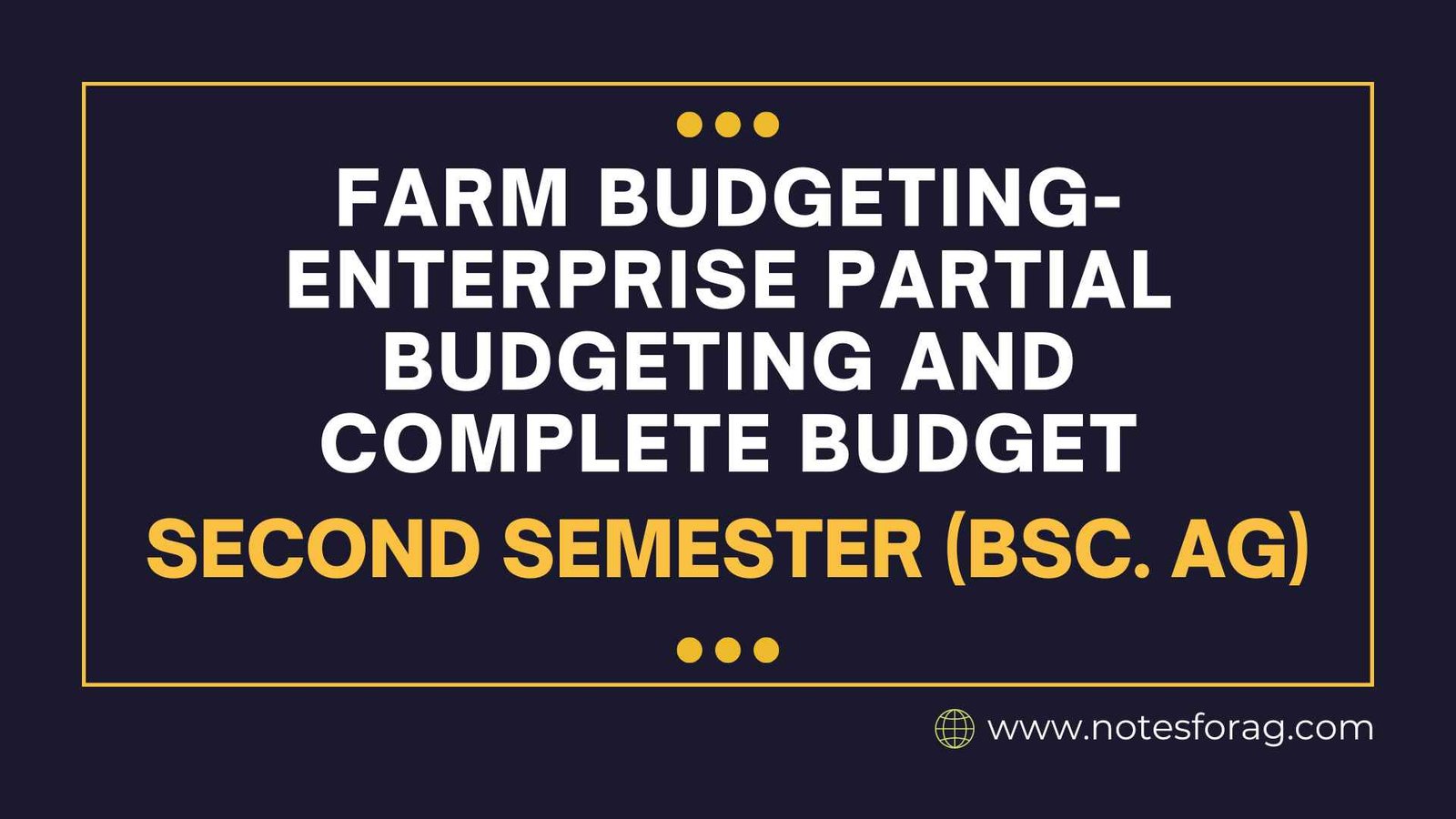Effective agricultural management requires the use of farm budgeting, which has two main components: enterprise partial budgeting and complete budgeting. A farming operation’s ability to assess the financial effects of particular changes, like implementing new technologies or changing production methods, is the main goal of enterprise partial budgeting. The proposed change’s net effect is calculated by taking into account increased expenses, decreased revenues, and additional revenues. On the other hand, a comprehensive budget offers a holistic perspective for long-term planning and strategic decision-making by taking into account all sources of income, expenses, capital expenditures, and cash flow for the entire farm. These farm budgeting techniques work together to maximize resource utilization and increase profitability for farmers.
Table of Contents
Introduction to Farm Budgeting
Utilizing farm budgeting as a vital instrument for financial management, it forms the basis of contemporary agriculture. The profitability and sustainability of farming operations can be improved by farmers through methodical cost planning and control, revenue optimization, and risk management. In order to help farmers make well-informed decisions and allocate resources effectively, organized financial techniques must be applied to farm budgeting.

There are two primary categories of farm budgeting: enterprise partial budgeting and complete budgeting. Assessing the financial effects of minor adjustments made to a particular business or operation is the main goal of enterprise partial budgeting. It is a helpful tool for determining whether new practices or investments are feasible and for making small, gradual improvements. However, a comprehensive financial plan covering all businesses and activities on the farm is provided by complete budgeting. This approach facilitates long-term strategic planning and provides a comprehensive picture of the farm’s financial situation.
Understanding Enterprise Partial Budgeting
Farmers can evaluate the effects of minor modifications or adjustments within a particular farm enterprise by using enterprise partial budgeting, a financial analysis tool. A useful tool for decision-making, partial budgeting concentrates on small adjustments as opposed to accounting for every financial aspect of the farm in a complete budget.

The four main components of partial budgeting are reduced revenue, additional costs, additional revenue, and reduced costs. Farmers can gain a better understanding of the possible financial consequences of their choices by dissecting these elements.
- Additional Costs: These are the extra expenses a farmer may have to pay after making a change. Adopting a new technology, for instance, might necessitate a one-time equipment and training investment.
- Reduced Revenue: This element takes into consideration any potential revenue loss as a result of the modification. For example, yields during the transition period may be lower if you switch to a different crop.
- Additional Revenue: This refers to any fresh sources of income that the modification may create. For instance, expanding into a new livestock or crop enterprise could lead to the opening of new markets and an increase in overall revenue.
- Reduced Costs: These are the savings that the modification brought about. Using more effective irrigation methods, for instance, could result in lower water use and utility costs.
Partial budgeting is a tool that farmers can use to assess different options. Partial budgeting, for example, can be used by a farmer thinking about implementing precision agriculture technology to balance the extra expenses against the possibility of higher profits and lower input costs. In a similar vein, a livestock farmer thinking about changing feed practices can evaluate how any potential drop in productivity might be balanced against the lower feed costs.
Comprehensive Overview of Complete Budgeting
Comprehensive budgeting, sometimes referred to as whole farm budgeting, is an all-encompassing method of examining a farm’s financial operations. This approach includes a detailed analysis of all financial components, such as assets, liabilities, income, and expenses. Providing a thorough financial plan that directs the farm’s operations and aids in decision-making and long-term financial stability is the main goal of comprehensive budgeting.
Establishing specific financial goals is the first step in the process of making an entire budget. These objectives function as a road map, outlining the farm’s financial objectives over a given time frame. After objectives are set, the next stage is to collect a lot of information about the farm’s financial situation right now. This comprises thorough records of all sources of income, costs incurred for operations and capital projects, and any outstanding debts or liabilities. Precise data collection is essential since it serves as the basis for the entire budget.
Farmers are able to forecast future financial success once they have the relevant data. Using historical trends, current market conditions, and anticipated shifts in output levels, one might estimate future income in this way. Plotting future costs is also necessary; these projections should include both permanent costs, such as insurance and property taxes, and variable costs, including feed, labor, and maintenance. For the budget to stay stable in a range of circumstances, the estimates need to be reasonable and take into consideration any risks or uncertainties.
Complete budgeting works, as demonstrated by case studies and real-world situations. A dairy farm, for example, might use full budgeting to prepare for herd expansion. The farm can assess if expanding is financially feasible by weighing the increase in milk sales revenue against the higher expenses for facilities, labor, and feed. Complete budgeting can also be used by a crop farm to assess the financial effects of implementing new farming techniques or technology.
Integrating Partial and Complete Budgeting for Optimal Farm Management
Enterprise partial budgeting and complete budgeting must be strategically integrated for effective farm management. Even though these two budgeting techniques have different uses, they work well together to create a complete financial management plan in farm budgeting. Farmers are better able to handle the complexity of agricultural operations with more accuracy and foresight when they combine the characteristics of both approaches.
For short-term decision-making, partial budgeting is a useful tool that helps farmers assess the financial effects of particular projects or adjustments. Partial budgeting offers a targeted review of the incremental costs and benefits of any changes to production processes, equipment purchases, or crop varieties. With this focused strategy, farmers may make well-informed decisions that will improve their short-term profitability and operational efficiency.
Complete budgeting, on the other hand, provides a long-term financial structure that covers the whole farming enterprise. It entails a full evaluation of all sources of income, costs, assets, and liabilities in order to present a complete picture of the sustainability and financial health of the farm. Completing a budget enables farmers to successfully manage risks, plan for future growth, and distribute resources over several seasons or years.
It’s critical to strike a balance between partial and complete budgeting methods in order to attain best farm management. For assessing targeted, immediate improvements, farmers should use partial budgeting; for comprehensive, long-term strategic planning, they should use complete budgeting. Farmers may effectively handle both urgent demands and long-term aims by knowing when to employ each strategy.
Farm budgeting involves two primary approaches: enterprise partial budgeting and complete budgeting. Through an analysis of increased expenses, decreased revenues, increased revenues, and decreased expenses, enterprise partial budgeting determines the net effect of a change.
Frequently Asked Question(FAQ)
What is enterprise partial budgeting in farm management?
An existing farm enterprise can assess the financial effects of a particular modification or adjustment by using enterprise partial budgeting. In order to determine the proposed change’s net financial impact, it takes into account increased expenses, decreased revenues, and new revenues.
What are the main components of a partial budget?
The main components of a partial budget are:Additional Costs, Reduced Revenue, Additional Revenue, Reduced Costs.
Related Articles

